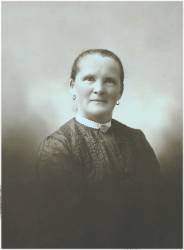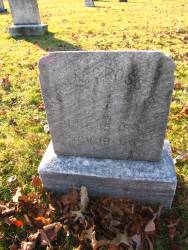

 Franz A Grosspietsch (Grossbeck) (Franz Frantz Grossbak Franciszek Francis August Augustus Grossback Großpietsch Grosspitsch)
Franz A Grosspietsch (Grossbeck) (Franz Frantz Grossbak Franciszek Francis August Augustus Grossback Großpietsch Grosspitsch) 
|
|
Birth Notes
b. perhaps Gabersdorf, near Neider Wustegiersdorf(Wüstegiersdorf)(Ober Wüste Giersdorf), now Gluszyca (previously Wustegiersdorf ) on daughter's and son's birth certificate, near Waldenburg or now in Poland, Walbrzych about 1 1/2 miles to the Czech border.
Ship's record says born in 1840
Or possibly Charlottenbrunn?, Silesia, Prussia, now called Jedlina-Zdrój
Death Notes
Lived at 39 Madison St., Paterson, New Jersey at death.
Internment 9752 by burial records from Cedar Lawn Cemetary, section 13, lot C, grave 371
Place of death was listed as being Sandy Hill, Paterson, NJ. There was an old cemetery"Sandy Hill Cemetery" closed in the early 1900. Franz may have been transferred from Sandy Hill to Cedar Lawn or he may have died in the Sandy Hill section of Paterson in what is now the 5th Ward.
New Jersey Deaths and Burials, 1720-1988 for Frank Grossbeck
Name: Frank Grossbeck
Death Date: 03 Jul 1890
Death Place: Paterson, Passaic, New Jersey
Age: 47
Birth Date: 1843
Birthplace: Ger
Occupation: News Dealer
Race: White
Marital Status: Married
Indexing Project (Batch) Number: B06609-9
System Origin: New Jersey-EASy
Source Film Number: 589788
Reference Number: v 32 p 197
General Notes
Pictures from next generation up were from Charlottenbrunn. They may have been from there or died there. A relative has told us the family was Jewish and converted after they moved to the USA. Wedon't know if all of this generation were Jewish or just one. A DNA of a relative indicates that only one of the four in this generation was Jewish.
Arrived August 9, 1869, New York. was a weaver, on ship Columbia from Germans to America book, Data file, 1850-1897, identified As Grossputch
https://www.dropbox.com/s/hm2tz7gevoqbi91/Screenshot%202016-06-27%2015.38.04.png?dl=0
https://familysearch.org/search/record/results?count=20&query=%2Bgivenname%3AFranz~%20%2Bsurname%3AGrossputsch~%20%2Brecord_type%3A(4)
Naturalization oct. 30,1876, first papers filed 2-9-1873
In the US, no later than 1871 by Citizenship Papers, probably 1869 when Amelia ia shown as coming to the US
Paterson City Directory listings:
1874 Francis Grosspietsch lived at 223 Water Street, Paterson, New Jersey
1876 Frank Grosspietsch lived at 6th n Temple, Paterson, New Jersey
1880 lived at 24 Haris Street, Paterson, New Jersey
1890 Widow lived at 464 main st. Patterson, NJ,
1891 widow lived 38 Canal St. Patterson, New Jersey
1913 widow lived 25 Totowa Av with daughter
Prussia, now Poland, Gluszyca, now located in Southwest Poland, near Waldenburg (Walbrzych) near the Czech border in the province of Silesia (Schlesien)
An old letter read by one of the relatives described relatives as being "Prussian peasants".
Silesia (Polish: Slask; German: Schlesien; Czech: Slezsko) is a region in central Europe. It spreads either side of the upper Oder River. Today, the vast majority of Silesia is within Poland. For several centuries prior to World War II, most of Silesia was German (Prussian or Austrian).
Silesia was settled by Slavs in the 6th century. In the tenth century, the central Polish tribes were united under Miesko I (960-92), whose son, Boleslaw Chobry (992-1025) expanded the area to include Silesia and other areas. These rulers encouraged Germans to settle in Silesia.
Breslau became the capital of the Duchy of Silesia in the 12th Century. By the 13th century, many Germans had settled in the area west of the Oder and in Silesia itself. In 1335, the Duchy of Silesia became subsidiary to the Kingdom of Bohemia. Silesia was then acquired by the Austrian Habsburg Charles V when he acquired the Kingdom of Bohemia in 1526. For a short while prior to this, Silesia was part of the Empire of Mathias Corvinus from 1485 to 1490.
Under Frederick the Great (Friedrich der Grosse), Prussia conquered Upper and Lower Silesia in the First Silesian War. This territory was formally annexed by Prussia in the Treaty of Breslau in 1742. Austria attempted reconquest in 1745 (Battle of Hohenfriedberg), but Prussia retained control after the Second Silesian War. These wars were part of the much wider War of the Austrian Succession (1740-48). Silesia then remained a province of Prussia.
During the Seven Years War, Prussia occupied Bohemia as far as Prague, but was then ejected from Bohemia. Austria then attempted unsuccessfully to recover Silesia, losing the Battle of Leuthen (1757) (near Breslau).
Prussia subsequently acquired more territory to the east with the successive partitions of Poland between Russia, Austria and Prussia.
Silesia again became a focus of the Austrian-Prussian rivalry in 1866, culminating in the Austrian defeat at the Battle of Koniggratz in Bohemia. Austrian subsequently was forced "to renounce all part in the hegemony of Germany". (von Moltke)
Silesia, as a province of Prussia, became part of the German Empire in 1871.
After Germany's defeat in World War I, a small portion of Upper Silesia was ceded to Poland. At the same time, with the breakup of the Habsburg Empire, Austrian Silesia was divided between Poland and Czechoslovakia.
After World War II, all of German Silesia was transferred to Poland, with the exception of Lusatia, which became part of East Germany. About 3.5 million Germans left the region, which was then repopulated with Poles. Nevertheless, a large ethnic German minority (between 600,000 and remained under Polish rule.
Boyd's Paterson Directory 1886-87800,000 in 1990), Frank Grossbeck, weaver, h 464 main st. Patterson, NJ, 1890-1893, Amelia, widow, 38 Canal St. Patterson, New Jersey
Paterson, New Jersey, City Directory, 1874, Francis Grosspietsch lived at 223 Water Street
Told by a relative, she was told, both Wiesner's and Grosspietsch's were Jewish and converted to being Prostestant when they came to this country.
-
Individual Additional Information
-
Associated external link media/ind00051.htm
-
Other Attributes
death.DISPOSITION.SO.RCE @source00001@
-
Other Attributes
Wife's Pictures
Franz and Amelia were married. They had three sons and four daughters, named Heny, John, ?, Mila, Pauline, Lizzie and ? infant.
-
Children
Birth Notes
b. 1871/72 Paterson, New Jersey by Paterson vital records, Vol. CD, page 244, listed as Amelia Grosbeck, date of birth was listed as being 1872 on cemetery headstoneDeath Notes
d. lived at 1020 19th St., Paterson, New Jersey at time of death
Buried Cedar Lawn Cemetery, Paterson, New Jersey, section 15, lot 639, grave 2
Birth Notes
witness to baptism was Pauline Kramer, (sister?)Death Notes
d. bef, 1885 Paterson, New JerseyBirth Notes
or 30 by WW1 draft card
state 1910 census
Death Notes
d.Direct family information tells the following story:
Rudolph Christ, Henry's brother-in-law, came home from the doctors office, (he had minor surgery in the doctors office). The two men were living together after the death of Rudolph's wife Lizzie. The doctor gave him pain medicine (Laudum). He sat down in the living room not knowing the house was filling with gas. . In the kitchen, "Heni" had his head in the oven with the gas on. Both men died from gas poisoning. "Heni" was considered to be troubled and a little different . Rudolph Christ probably couldn't smell the gas due to the pain medication. They were found by Rudolph Christ's daughter Doris (Christ) Esso. She was 24 at the time. The Christ house address was 25 Totowa Ave Paterson New Jersey.
Burial Plot Section 13, lot C, #368Birth Notes
state 1910 censusDeath Notes
Pobably had Alzheimer's DiseaseBirth Notes
New Jersey Births and Christenings, 1660-1980 for John E. Grossbeck
Name: John E. Grossbeck
Birth Date: 02 Feb 1882/1883?
Birthplace: Paterson, Passaic, New Jersey
Father's Name: Frank Grossbeck
Mother's Name: Weisner
Indexing Project (Batch) Number: I04761-0
System Origin: New Jersey-EASy
Source Film Number: 494196
Reference Number:Death Notes
Burial Plot Section 13, C, #368, died of diabetes related problems. He was sent to Barbados to help with his disease.
Birth Notes
died at 1 day oldDeath Notes
http://search.ancestry.com/cgi-bin/sse.dll?_phsrc=jHH838&_phstart=successSource&usePUBJs=true&uidh=000&rank=1&new=1&msT=1&gsfn=Frantz&gsln=Grosspietsch&gss=angs-g&MSAV=0&cj=1&srchb=r&gspl=2,Any%20Locality&pcc=2&prox=1&netid=cj&o_xid=0000584978&o_lid=0000584978&o_sch=Affiliate%20External&noredir=true&pcat=ROOT_CATEGORY&h=2211308&recoff=6%2052%2053&db=FSPhilPADeath&indiv=1&ml_rpos=5
 Amelia (Emily)(Amilia)(Amalie) (Mila) Wilhemina Grossbeck (Grosbeck)
Amelia (Emily)(Amilia)(Amalie) (Mila) Wilhemina Grossbeck (Grosbeck)
Amelia (Emily)(Amilia)(Amalie), known as Mila, was born on May 8th, 1871 in Paterson, Passaic County, New Jersey.
 Pauline Anna Grossbeck (Grosspietsch)
Pauline Anna Grossbeck (Grosspietsch)
Pauline was born on June 8th, 1874 in Paterson, Passaic, New Jerdey.
 Wilhelm (Heny) Heinrich Grossbeck (Grosspietsch)
Wilhelm (Heny) Heinrich Grossbeck (Grosspietsch)
Wilhelm, known as Heny, was born on December 30th, 1876 in Paterson,New Jersey and his christening took place on May 20th, 1977 in Stohlmann, 22 N William St. New York.
 Elizabeth (Lizzie) Augustus Grossbeck (Grosspietsch)
Elizabeth (Lizzie) Augustus Grossbeck (Grosspietsch)
Elizabeth, known as Lizzie, was born on December 25th, 1878 in Paterson, Passaic, New Jerdey and her confirmation took place on March 26th, 1993 in Paterson, Passaic County, New Jersey.
 John Arthur Grossbeck
John Arthur Grossbeck
John was born on February 2nd, 1882 in Paterson, New Jersey.
 ? Grosspietsch?
? Grosspietsch?
? was born on October 29th, 1883 in Philedelphia, Pennsylvania.

















